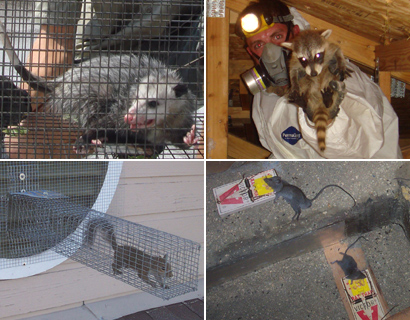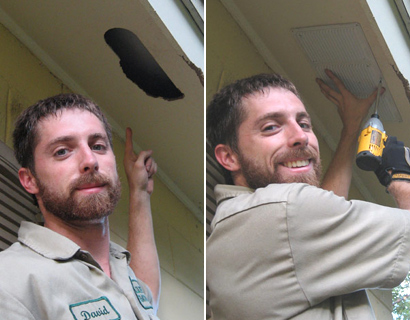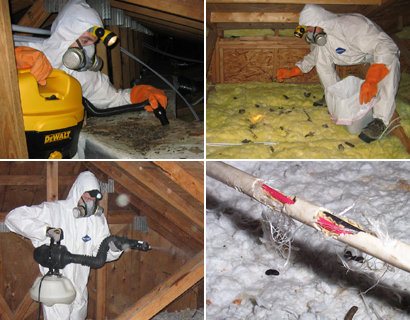- How We Solve Wildlife Problems
How We Solve Kansas City Wildlife Problems
INSPECTION: Once on site, we will perform a full inspection of your home and property. This allows us to use the correct strategy and traps. If the animals are in an attic, a full building inspection is crucial, including the following:
- All ground-level areas, such as piper or A/C line entry & exit areas, A/C chase bottoms, ground-level vents, etc.
- All mid-level areas, such as dryer vents, siding gaps, first floor eaves or dormers, etc.
- We inspect the entire roof, including all plumbing stacks, ridge caps, vents, and other potential gaps or holes.
- We also inspect inside your attic, to identify animals and damage they have caused.
- If the animals are outside, we notice many subtle clues that will assist us in a successful strategy.
TRAPPING, EXCLUSION, REMOVAL: Once we understand what animal species we are dealing with, and the problem, we use the most effective means of removing the animals. We use dozens of different types of traps.
- Trapping - If trapping the animal(s) in live cage traps, trap type, set, and location are crucial to success.
- Exclusion - Oftentimes, we are able to simply set one-way doors or other exclusion devices that allow the animals inside a building to safely exit, but never get back inside.
- Removal By Hand - Sometimes we actually remove animals by hand, or with special tools like snare poles.
- The Law - In all cases, we obey state and local laws regarding wildlife, but aim to take the most humane approach.
ENTRY HOLE REPAIRS: Repairs are a crucial step in the wildlife removal process. In many cases, such as bat or rodent control, the job cannot be performed without detailed repairs, and in all cases, sealing the entry holes shut ensures that no future wildlife will ever enter your home.
- 100% of the entry holes must be found, and sealed shut, or the job is not complete.
- Our repairs are professional contractor grade, look good, and when applicable we use steel, which rodents such as rats or squirrels are unable to chew through.
- We give a written guarantee on our repairs against any future animal entry.
ATTIC DECONTAMINATION SERVICES: It may be desirable to clean your attic after we've removed the animals. They can leave behind large amounts of droppings, urine, hair, oils, food, nesting material, and so on. These remnants can attract insects like cockroaches, and the scent left behind can encourage new animals to chew their way into your house. You might experience odor problems from the waste. It's possible that mold will grow on waste areas.
- We remove or vacuum all droppings, or remove all the soiled insulation.
- We fog the attic with a special enzyme-based cleaner that destroys any organic matter and deodorizes the space.
- We repair damage, such as ductwork, electrical wires, pipes, insulation, and more.
As a midwestern state, Kansas has raccoons, skunks, squirrels, opossums, bats, moles, and groundhogs. There are few venomous snakes. We service the greater Kansas City region, both in Kansas and Missouri. In Kansas we service Johnson County KS and Wyandotte County KS, and the towns of Overland Park, Olathe, Shawnee, Lenexa, Leavenworth, Leawood, and more. In Missouri, we service Jackson County MO and Clay County MO, and the towns of Prairie Village, Gardner, Ottawa, Lansing, Independence, Lee's Summit, Blue Springs, Liberty, Raytown, Gladstone, Grandview, Belton, Raymore, Grain Valley, and more.
This month's wildlife how-to article: Opossum prevention
How to keep opossums away from your house and yard - Weighing it at around the same size as the average house cat, the opossum is a rather strange creature that has been dated to as far back as the dinosaurs! With more than a few tricks up its sleeve, and a tendency to “play dead” for any unsuspecting predator or human, it is no wonder that this rather bizarre creature has stood the test of time, and has become more and more of a wildlife problem for many people.
The thing about the opossum is that it is an incredibly resilient animal with a very varied diet. Just like us humans, they are omnivores so they will eat meat as well as vegetables, and this is what makes it incredibly hard to prevent them from getting into your yard. With most other rodents or wildlife problems, when you remove the food source, the animal tends to go away, but with this creature, if you remove the food source, such as cleaning the barbecue, not leaving food out for the cat or dog, make sure your garbage can is covered and similar things, the opossum will just go for the bugs that live in your garden such as snails and grubs, and also will turn to eating the roots of your plants in order to survive.
Other foods that the opossum love include eggs, fruits, beetles and scraps left over from humans, which as you can imagine, makes it increasingly hard to get rid of them!
Your back yard will provide the perfect home for any opossum, but especially one that is having babies. Just for the record, an opossum mother can have up to 25 babies in one “hit”, so if you have a mother in your yard, it is about to get rather crowded and more than a little destructive.
The one thing that we mentioned earlier, about the opossum “playing dead” is not actually a good thing, for you or the animal itself. It is easy for a human to dispose of a seemingly dead opossum, without even realising it is still alive, which can cause some rather dangerous positions for the animal. And you may think that you have successfully disposed of the pest, even when you haven’t. This is why it pays to be knowledgeable about such things.
As we have mentioned, opossum prevention can be difficult, especially when they have so many food sources that getting rid of them all would be virtually impossible. The one thing that has shown to have good results is to completely fence off your yard from the outside world with chicken wire, or a similar material. The only problem with this is that if you have a big yard, you will need a lot of it and you will also need it to be at least four feet high, with no supporting posts or spokes that the animal could use as a stairway of sorts.
The best thing that you can do for opossum prevention is to call on a wildlife control company. These guys will know exactly what to do and also can give you some rather invaluable advice to help you in your quest.
Go back to the Kansas City wildlife control home page.





